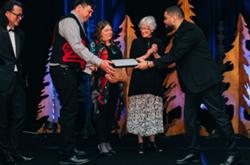
Related Document
Hemmed in by duplexes on either side, the courtyard at Penta Housing Co-operative features a communal garden, playground and massive willow trees.
It's the kind of place you'd want to raise kids: safe, secure and within walking distance to parks and the beach. And, in a neighborhood where houses sell for upwards of a million dollars, it's affordable for a one-income family.
That's why Bruce Inglis, his partner and their two children moved here five years ago (after waiting eight years to get in). The kids have since left home, but for Inglis, "It's hard for us to imagine living anywhere else."
Still, that's a reality he knows they might face one day. The buildings here are 30 years old, near the end of their shelf life, and that means maintenance costs are increasing.
"There's a finite point at which people can continue to repaint or patch up to keep things going," says Inglis.
Like many of the co-ops across British Columbia and Canada, Penta was built in the '70s with a wave of funding from federal government programs that both reduced the cost of the mortgage, and provided subsidies for low-income units.
These programs, which were delivered through operating agreements with individual co-ops and government, continued through the '80s and early '90s. The result was an affordable, diverse and community-based housing stock; there are now approximately 2,000 non-profit housing co-ops currently across the country. In British Columbia, 260 co-ops provide approximately 14,500 homes for mid- and low-income families.
But in the next 10 years, nearly half of the government operating agreements will expire, leaving many co-ops to effectively fend for themselves.
A new co-op generation?
Thom Armstrong, executive director of the B.C. Co-op Housing Federation, says there are a couple of implications to consider.
"On one hand are a whole bunch of wood-frame buildings nearing the end of their 30- or 40-year life. Co-op members are asking themselves, how long will my housing last?" he said.
"At the same time, when you don't any longer have a relationship with government, you don't have an obligation to do anything, other than what the laws of the land say, but neither do you have the security that came with the government financing."
"Is it just a stock of disposable housing, does it just run out and fall down? Or do we rebuild it, refinance it for another generation of co-op members?"
Can co-ops afford to stay affordable?
The question of how (or whether) to refinance and rebuild in the absence of government subsidies is up to individual co-ops. The Co-op Housing Federation of Canada offers a certification program, called 2020 Vision, that requires them to establish a mission statement and financial plan.
Working through the process, says Armstrong, will not only force co-ops to think about their future but also makes them more desirable to private financers.
"They're going to have to go to a commercial lender and say, based on the value of our property and based on our income stream... will you lend us the money to rebuild for another 40 or 50 years," said Armstrong.
"Co-ops haves spent years building really viable supportive communities, and now they're going to have to turn their attention to what it takes to be a real viable business as well."
Never too soon to plan
Scott Hughes, director of community business banking at VanCity has a word of advice: make sure to plan well in advance of when an operating agreement might end.
"Typically, the decision-making process is slower. They will need enough time to get the appraisals and inputs that they need."
Although property values and the amount of financing have shrunk, "low interest rates allow you to borrow more against the same stream of rental payments," he says.
Roofs and Roots Housing Co-operative has had the experience going it alone. Incorporated in 2001, they were the first new co-op in the Victoria area in 15 years.
"The major challenge for a new cooperative like ours was that we don't have an overarching authority, like the federal government, to provide us with a down payment or the benefits of subsidies," says board chair Pascale Knoglinger.
They had to raise equity from five different government and non-governmental funders ("with five different deadlines and requirements," Pascale notes) and find a seller patient enough to wait as they gathered a down payment.
'That's the Catch-22'
"For a co-op these days, you really have to find the right seller and have to have a really good relationship will all these different funders," she said.
Making sure that even low income people can afford co-op housing charges is more difficult, she says.
For example, in order to access certain funding from the Canada Mortgage and Housing Corporation, unit prices have to fall under the median income threshold.
If it was to obtain that funding, the co-op would have to lower some of the units' monthly fees, thereby decreasing revenue, said Knoglinger.
"You have to incur a deficit in order to meet the criteria," she says. "That's the whole thing, that's the catch-22."
'Sweat and time'
"It's hard for people who live in co-ops to think about developing new co-ops," says Sol Kinnis, Roofs and Roots co-founder. "It's a heck of a lot harder than I thought it would be."
She thinks existing co-ops could play a role in invigorating a new stock of housing by contributing to a development fund.
"If we contributed a certain amount of money every year towards a development fund, it could be used as leverage for government funding," she says.
But, as Inglis points out, the success of co-op housing depends on the people involved, not just the funding available.
"We moved here because it was affordable... but in the five years we've lived here we've had no choice but to get closer to the real costs," he says.
"Maybe not so much in real dollar costs, but on a monthly basis some of us contribute a lot of our sweat and time... easily several hundred dollars of my own labour. It's a value that people often forget about."
Related Tyee stories:
- The $18 Million Condo
Vancouver's new architectural paradigm: the insanely priced pied-á-terre. - Crazed by House Prices? Try 'Co-Housing'
Here's how our Vancouver experiment works. - The Prefab Home Is Suddenly Fab
Many are made in BC. Are they a real housing solution? A Tyee Special Report.
Read more: Housing, Urban Planning + Architecture

















Tyee Commenting Guidelines
Comments that violate guidelines risk being deleted, and violations may result in a temporary or permanent user ban. Maintain the spirit of good conversation to stay in the discussion.
*Please note The Tyee is not a forum for spreading misinformation about COVID-19, denying its existence or minimizing its risk to public health.
Do:
Do not: